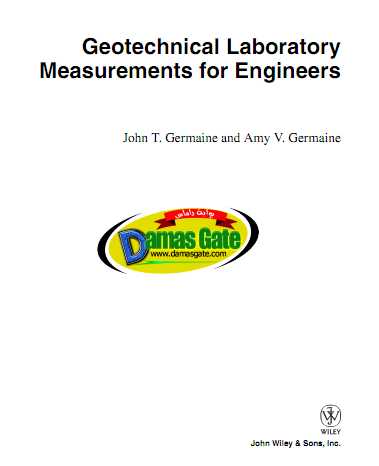Geotechnical Laboratory Measurements for Engineers

Preface
This textbook is divided into two parts, according to a general division of test result characteristics and level of background knowledge necessary to perform the tests. Part I focuses on relatively simple tests that are used to characterize the nature of soils and can be performed on bulk materials. Part II increases the level of testing complexity, places more emphasis on engineering properties, and requires a larger investment in laboratory equipment. These topics may be covered in an undergraduate
civil
or geotechnical engineering laboratory course.
An ancillary web site has been created for this textbook. The web site is divided by chapter and includes data sheets, spreadsheets, and example data sets. In addition, there are online resources for instructors that provide template data sheets with embedded data reduction formulas.
There are a large number of tests that are performed on geo - materials. This book is not intended to be all inclusive, but rather covers a selection of the most common and essential tests, while maintaining a broad cross - section of methods and devices. In general, testing of geo - materials is a slow process according to “ clock time. ” This is mostly due to the need for pore water to come to equilibrium. Cost - effective, high - quality testing is possible by understanding the important factors and working with nature to use labor wisely. A goal of this text is to provide guidance for effi cient testing without sacrifi cing
the quality of results. Effi
ciency
can be achieved
by tailoring techniques to individual
circumstances and understanding when
shortcuts are feasible.
The background chapter to each of the two parts provides general information that applies to the chapters that follow. Test - specifi c information is included in the pertinent chapter. Each testing chapter provides background information to understand the concepts and objectives of the method, a discussion of important factors useful for professional practice, a list of the minimum equipment requirements, detailed procedures and guidance for performing the test, and the calculations required to produce the results. The procedures are provided for specifi c situations and would be most useful for instructional
purposes. These instructions could be modifi
ed
for commercial application to increase productivity
and effi
ciency.
The text is set up to allow instructors to choose which laboratories to include in their courses. The knowledge gained through individual tests tends to be cumulative as the text progresses. However, it is not intended that all of the laboratories would be taught, one after the other, as part of a single course.
Although this book is well suited to teaching a geotechnical laboratory course, the practicing geotechnical engineer should fi nd this text useful as a reference on the important details relative to testing. This is especially important when designing
sophisticated subsurface characterization and corresponding advanced
laboratory testing programs. The information presented is essential to the geotechnical engineer.
The text helps develop a working knowledge of laboratory capabilities and
testing methods. Laboratory testing is also a large part of geotechnical research. Perhaps the most valuable experience is that the knowledge
gained by performing the laboratories reinforces the understanding of soil behavior.
It is hoped that the practicing engineer will understand the following motto: Only perform the tests you need. But if you need to do it, do it correctly.
Download
http://s18.alxa.net/s18/srvs2/01/Geo....Engineers.rar